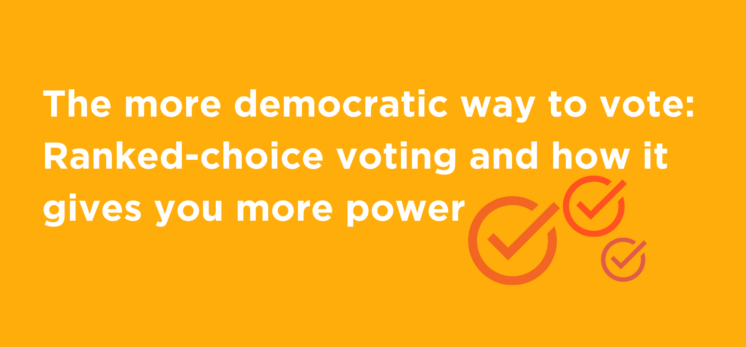Single-choice voting, or winner-takes-all voting, is what most of us are used to while voting in local and national elections in the United States. It may be the only kind of voting you knew was possible. You receive your ballot, fill in the circle of the one candidate you want to vote for, and you’re done.
But what if there were a better way of voting, one that gave you more power as a voter, let you vote your values, and actually ensured elections were more fair and functional for everyone?
The Pitfalls of Single-Choice Voting:
- You might feel like you have to vote for who you think will get the most votes or the lesser of two evils, instead of who you really want to choose or who represents your values best.
- This effect can shut people out from full participation in the democratic process by limiting meaningful choices for voters, and flattening participation and turnout from eligible voters.
- Pressure to stick with a party’s M.O. leads to less competitive elections at all levels and more predictable outcomes based on which party is the majority, leading to extreme polarization.
- Winner-take-all elections and single-choice ballots create starkly red and blue maps that silence tens of millions of voices.
Ranked-choice voting (RCV), also called instant-runoff voting, is a system of voting for as many candidates as you want and ranking the order in which you would like to see them elected.
If a candidate wins over 50% of the first-place votes, then that candidate wins right away. But, if no one gets over 50% of the vote (i.e., an absolute majority), the candidate with the fewest votes is eliminated and the process moves onto round two. If you ranked that candidate as your first choice, your vote will be transferred to count for your second choice in round two. The rounds continue until a candidate earns a majority vote and is declared the winner.
Here’s how it works:
Currently in the Bay Area, the cities of Oakland, San Francisco, Berkeley, and San Leandro use RCV. In 2020, voters approved RCV for the state of Alaska as well as cities including Boulder, Colorado, Minnetonka and Bloomington, Minnesota, and Eureka in California. Voters carried out successful RCV elections across the US in Maine, Minnesota, Colorado, Oregon, the Bay Area and more. Just last month, Measure BB officially passed with 73% support to institute proportional ranked-choice voting in Albany, CA. More voters supported Measure BB than any other measure in Albany’s history.
Both San Francisco and Oakland had impactful RCV races this past election season, ultimately electing several powerful progressive women of color at the local level endorsed by Bay Rising, including Myrna Melgar and Connie Chan in SF, and Carroll Fife in Oakland.
Connie Chan leveraged a coalition strategy in the later parts of her campaign to win her close race for supervisor in District 1. Joining with another Chinese American candidate, David Lee, in the final moments of their campaigns, both candidates encouraged supporters to rank them first and second. Despite their political differences, they campaigned on a platform of support for the Chinese American community of San Francisco, and unified their base through this approach.
The Pros of Ranked Choice Voting
- Winner-takes-all voting limits voter choice and leads to increased political polarization. RCV breaks up this trend, allowing more politically diverse candidates to run, and win.
- Instead of possibly ending up with a winning candidate that has less than 50% of overall votes, winning candidates are ensured to have real majority support.
- Instead of voting against the candidate you least agree with, you get to vote for the ones you most agree with.
- RCV gives fuller visibility to voter interests, from representation for historically underrepresented groups to political viewpoints, since they get to rank candidates if they want to vote for multiple.
- RCV allows for more candidates to run without fear of splitting the vote. This widens the field for values-driven candidates, and gives voters more choice — leading to increased voter turnout overall.
- Because RCV candidates are also vying for the second-choice votes of their opponents’ supporters, they are less likely to use shady, negative, and toxic campaigning tactics.
- RCV effectively removes the need for runoff elections, since it incorporates multiple rounds of voting already. This saves jurisdictions and voters a lot of money and time.
Learn more through FairVote.
Bay Rising supports our local partners and Risings to organize voters and build the political power of working-class communities of color. We back reforms like RCV that make voting more accessible, fair, and representative. RCV empowers voters to vote with their values, supports progressive and grassroots candidates of color, and makes elections more honest.
What kinds of voting rights reforms do you want to see?




